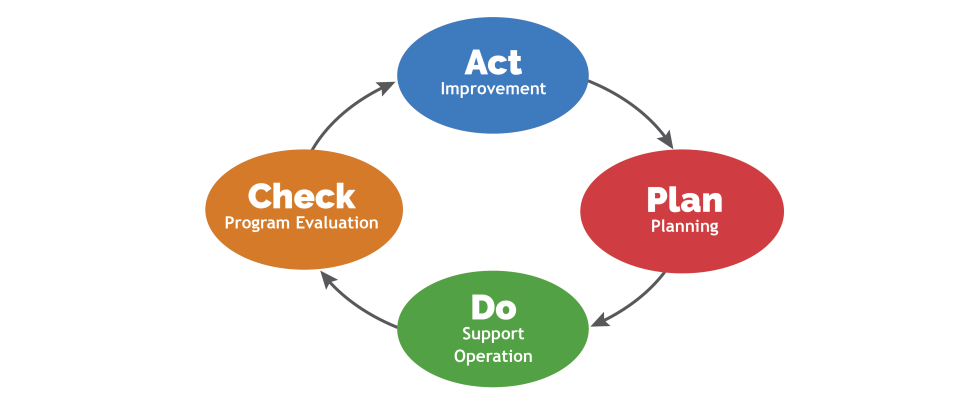Act - Fixing and Improving an EMS
The next phase of the PDCA cycle is “Act.” During this phase, the organization fixes and improves its EMS. For example, the organization may execute corrective action plans and make necessary updates to improve performance.

The information below illustrates the last five steps that are part of the “Act” process. The tasks described in the “Plan,” “Do,” and “Check” phases should be completed prior to implementing these final steps.
- Step 23: Establish and Implement Corrective Action Plans
- Step 24: Determine the Status of Environmental Objectives
- Step 25: Update EMS Policies and Procedures and Communicate Any Changes
- Step 26: Conduct Management Review
- Step 27: Communicate EMS Successes to the Organization
Step 23: Establish and Implement Corrective Action Plans
During the “Check” phase, the EMS team looks for nonconformances or ways in which the organization is not meeting EMS requirements or satisfying environmental objectives and obligations. For example, the team may detect problems through internal audits, compliance evaluations, emergency drills, real-world emergencies, facility inspections, and staff or stakeholder surveys.
When a nonconformance occurs, the EMS team must correct it and mitigate resulting environmental impacts. First, the team should identify the cause of the nonconformance so that it will be able to prevent reoccurrence. Then, the team should identify an appropriate corrective action, document it in a corrective action plan and fix the issue.
| Nonconformance | Cause | Corrective Action |
|---|---|---|
| Improper waste sorting - an internal auditor found recyclables in landfill-bound trash | Office staff don't know what is recyclable and what is not |
Conduct training for staff Develop clear signage and appropriate labels to post on or next to bins |
| Improper labeling of hazardous waste - an auditor found hazardous waste collection containers missing accumulation start date | New onsite contractor responsible for waste collection was not properly trained in labeling containers | Update contract language to ensure that all contract employees receive RCRA hazardous waste management training and hazard communication training |
Step 24: Determine the Status of Environmental Objectives
When focusing on improvement, it is important for an organization to periodically examine the status of its environmental objectives to determine which ones have been met and what remains to be done to achieve those that have not. If an objective has not yet been met, the organization will need to ask itself:
- Should we continue to pursue the objective?
- Why hasn't it been completed? Is it behind schedule? Did something get in the way (e.g., time, resources, shifting operations)?
- What do we need to change to achieve future success?
Step 25: Update EMS Policies and Procedures, and Communicate Any Changes
During the “Check” phase, the organization reviewed its policies and procedures to determine whether changes or tweaks were needed (see Step 22). If so, the organization should make those changes official during the “Act” phase by completing any required approval process and communicating the changes to all impacted employees.
Step 26: Conduct Management Review
The EMS team should create a summary of the organization’s EMS performance and present it to top management. This gives top management the opportunity to draw conclusions about the effectiveness of the EMS, examine opportunities for improvement and determine if the EMS needs to be modified to match the strategic direction of the organization.
At a minimum, management reviews should cover the following topics:
- Internal audit results
- Status of environmental objectives
- Adequacy of resources
- Opportunities for continual improvement
- Changes in significant environmental aspects
- Status of corrective actions
Organizations should document management reviews, distribute meeting notes to the EMS team and send resulting action items to the responsible parties identified under Step 4 and Step 11.
Step 27: Communicate EMS Successes to the Organization
Establishing an EMS (or maintaining and improving an existing one through another PDCA cycle) is no small feat. Be proud of the accomplishment and make sure to share information about tangible successes with the entire organization! Sending out an email or newsletter or posting information on the organization’s intranet site are great ways to share EMS news and keep employees involved and informed.
What Next?
Keep the cycle going. Return to the initial “Plan” phase for continual improvement of your EMS.
